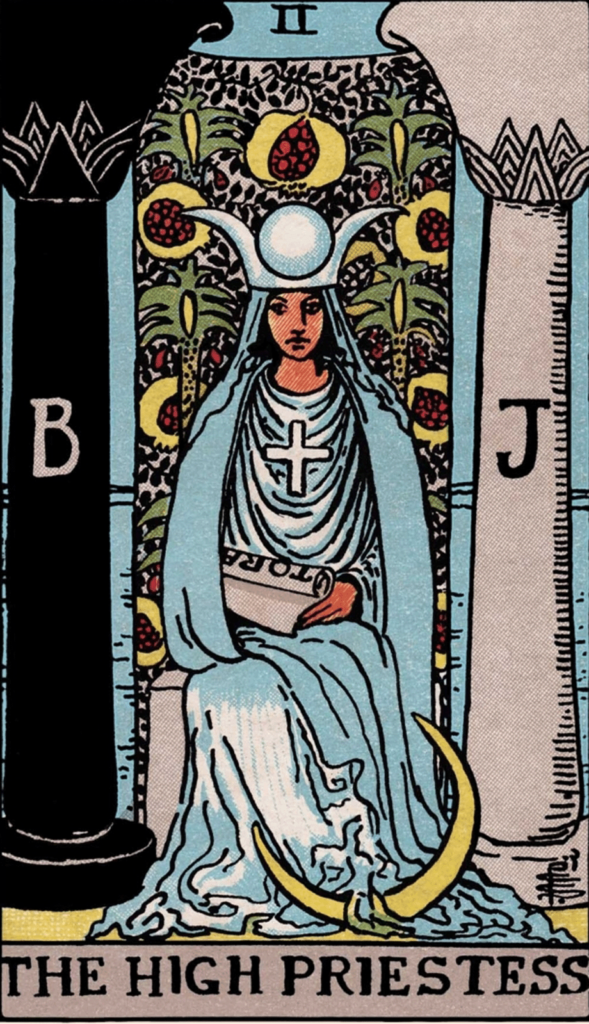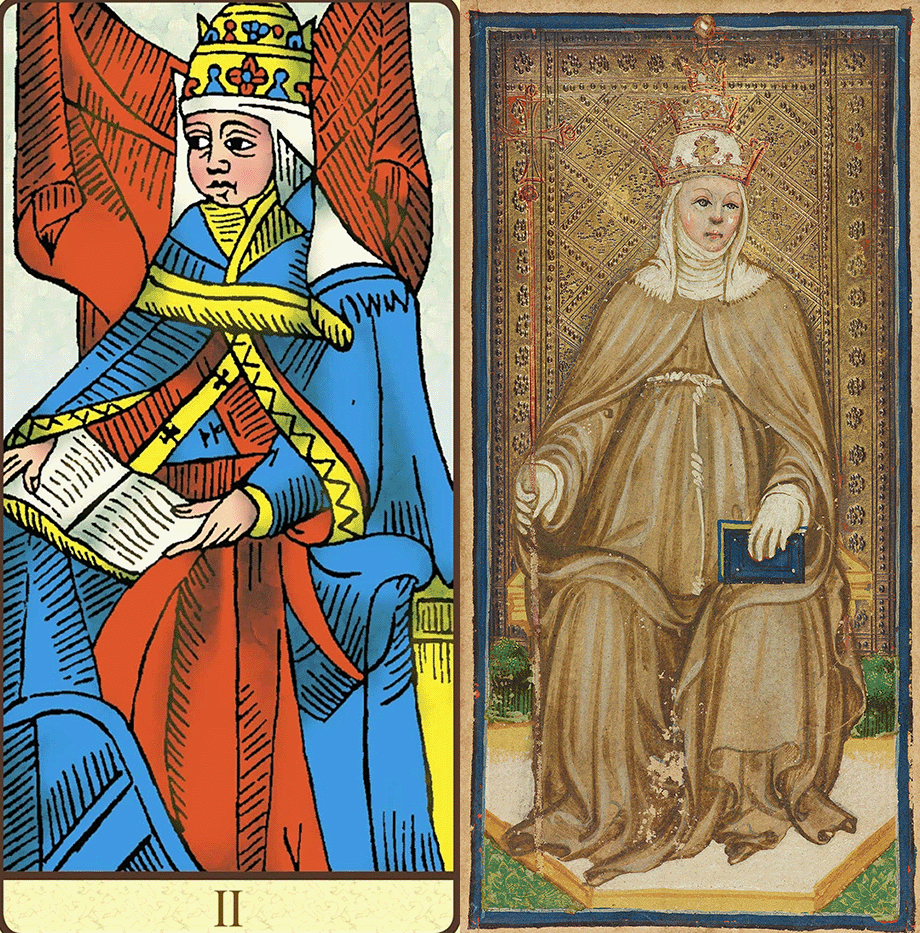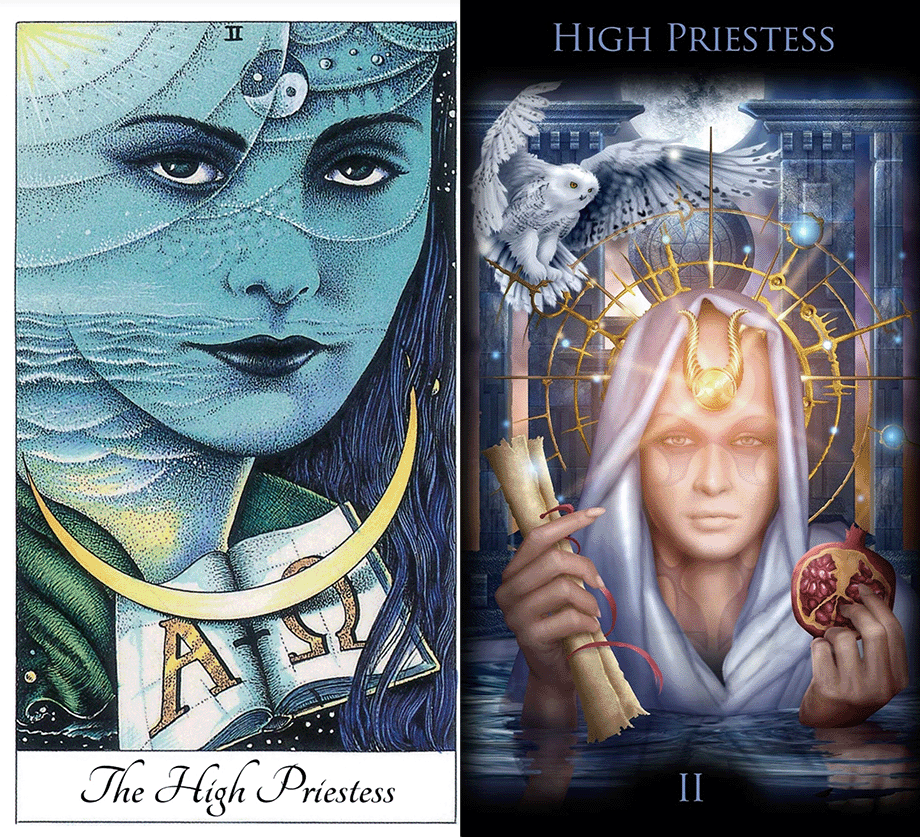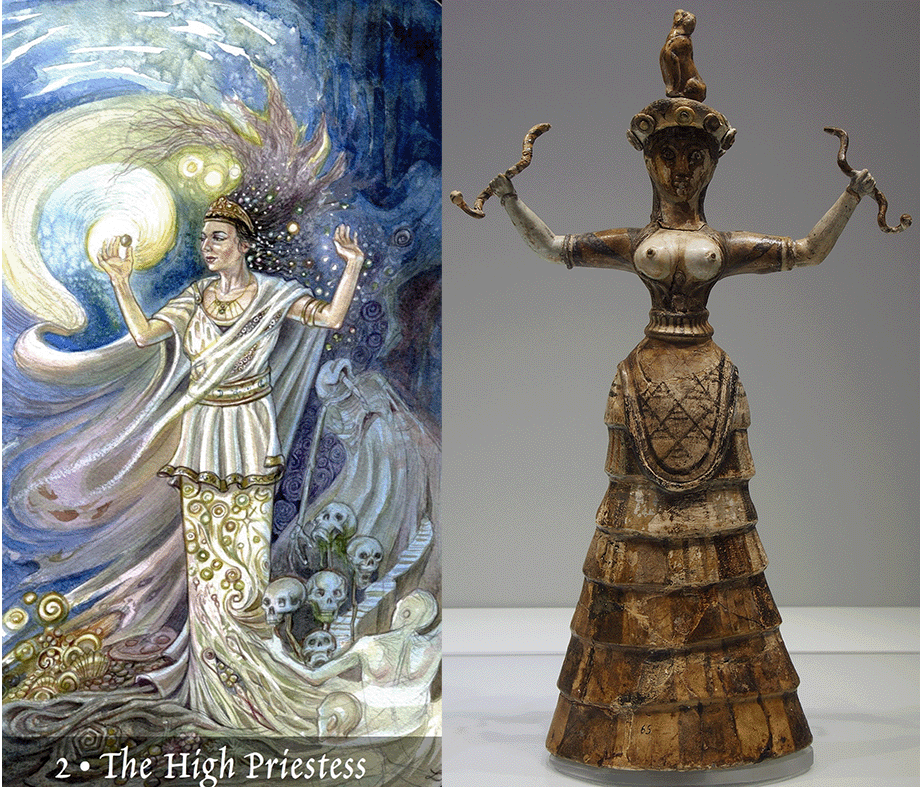When it comes to the origins of the third of the Major Arcana, we are clouted soundly across the face by a great patriarchal misogyny. The High Priestess as she is styled today in the RWS deck and it’s derivatives, was a symbol of derision and sacrilege. Her former title, that of “Papess” or “Popess” carries a complex history interwoven with the Medieval Church and its politics.
Though sources differ, the most likely source for this character is the story of Pope Joan. Supposedly, in the early days of the church, a woman (gasp) disguised as a man entered the priesthood, and was so successful that she ultimately was elected to it’s highest office, that of the Holy Father, or rather Mother. And mothering, according to the story, was ultimately her downfall, because in addition to committing the great sins of cross-dressing, impersonating a man, and becoming a priest (which is still not legal in the Catholic Church) she also fornicated and got with child. Going into labor during a long procession through the streets of Rome, she gave birth to a son (and some say it was AntiChrist) at which point the crowds tore her to pieces.
It’s hard to say where the story actually came from. Some believe it was created by the Church itself in order to show just how terrible an idea it was to give women rights. Other sources consider it to have risen during Protestant times as an example of the wickedness and corruption of the old order.
There sort of was actually a female pope, who is connected by extension to the Tarot’s rich tapestry of tales. In the 13th Century, Guglielma of Bohemia proclaimed herself to be an incarnation of the Christ and thus equal to the Pope in Rome. Among her other prophecies was the idea of a female papacy. She was quickly executed for heresy, but her followers elected another woman named Manfreda as her successor, thus claiming an apostolic succession of their own. The sect was ultimately suppressed, but this Manfreda was apparently a relation or ancestor of the Duchess of Sforza, whose family commissioned the Visconti-Sforza Tarot now in the collection of the Morgan Library.
For whatever reason, the Popess is historically depicted as a female version of the Catholic Pontiff. Remember that these trumps were originally for playing a card game, and not intended to have any deep esoteric meaning that we know of. So incorporating Pope Joan may have been a slap at the clergy in an era of emerging secular humanism, or it may simply have been a case of “Hey, Luigi, we need to come up with another card. Whadda ya think? We already got a Pope, how about She-Pope?”
Fast forward to the late 19th and early 20th centuries when these cards are transitioning from Catholic France and Italy into Protestant England, which had at the time a female head of the Church in Queen Victoria, and the figure perforce needed to take on a different character. We can find some of that character’s evolution in Smith’s depiction.

The High Priestess sits between a black column and a white column. inscribed with the letters B and J respectively, and capped with a lotus flower. Between them is draped a curtain adorned with what may be pomegranates. She wears a white crown or headdress with a sphere in the middle and horns or half crescents to either side, from which extends a veil. On her chest hovers a Tau cross. She holds in her hands a scroll with the word “TORA” written on it. A loose blue cloak covers her shoulders and is drawn across her lap. Her dress is of some thin material, that pools about her. At her right foot is a crescent moon shape. Behind her, visible only slightly through gaps between the curtain and the columns, may be seen a vast sea and the intimations of a distant shore across it.
I think it is very likely that Smith had access to a copy of the Sforza Popess card when she designed this. If we look at the Marseilles, which were the common predecessors in circulation, and we look to the Sforza, we can find closer visual structure with this earlier Italian version. While the Priestess no longer sports the triple crown, the distinctive shape of her head gear may be seen as exaggerating the lowest of those crowns. The central jewel becomes the “moon globe” and the side crenulations – already curving a bit in the Sforza painting, become the “horns”. Very frequently this crown is called a “Crown of Isis” or the “Crown of Hathor”, referring to the horned disk often depicted on those deities in the artwork of Egypt. This always draws the connection between Isis and the High Priestess, and, fair enough, it’s a connection I make as well, but I don’t stop there. There are a lot of other clues to be found.

Those are Egyptian columns, after all, so why not just accept the Hathor Crown as canon and move on. Except, though they are Egyptian in style, the columns are labeled with B for Boaz, and J for Joachim, or Jachin. These columns come to the Tarot by way of Freemasonry, where they are used both symbolically and as part of initiation ritual. The origin in both cases is in biblical accounts the Temple built by Solomon to house the Ark of the Covenant when Israel had been established as a nation and the capital was in Jerusalem.
In the biblical versions, the two columns were made of bronze and their decorations included pomegranates, lilies (lotuses), and “mesh-work” or some kind of screen. If we accept their existence as historical fact, their purpose was likely ritualistic, or totemic. They constituted a magical threshold between the ordinary space of the world, and the sacred space of the Temple within. We can find the antecedents of such magical structures in the Pylons guarding the openings to Egyptian holy sites, or things like the Ishtar Gate of Babylon and the Lion Gate in Nineveh, and the the symbolism continues down to the Arch de’ Triumphe and the Gateway Arch in St. Louis.
The names have no good provenance, but they are generally said to mean “Strength” and “Establishment”. Since Hebrew is read right to left, we are looking at the phrase as Jachin Boaz which is usually rendered as “He will establish in strength”. Yet esoterically, and this is symbolized by the black and white colors of the columns – rather than the bronze they are made of, the two columns represent all opposing or dualistic forces in the cosmos. In this case “Establishment” may be read as “Structure”, or “That Which Is” or “Matter” and “Strength” then becomes “Force”, or “That Which Changes” or “Energy”.
We may find here a parallel to the attribution of Saturn and Jupiter to the Magician. The universe is a dualistic existence (or at least may be expressed this way) where everything is the result of the tension (or balance) between opposite points. It is not correct to see either point in terms of good or evil, because they are simply the nodes that make possible the spectra between them.

On the left is the card from the Cosmic Tarot by artist and esotericist Norbert Lösche. His aesthetic reflects his studies in Tibetan Buddhism as much as a deep understanding of Western Tarot iconography. He keeps her veil, the moon, the waters, and the book. expressing them in a surrealist everyspace that transcends time itself. The Alpha and Omega, though derived from Christian biblical text, effectively communicate the same extremes as the black and white columns, which are in this case show very accurately as Tao.
The right side is from the Legacy of the Divine Tarot by Italian artist Cirro Marchetti. I have two of his decks, and will probably be adding the others. His art is deliciously sensual and innovative. Like Lösche he preserves key pieces of the symbol language, while introducing or interpreting others. He has her holding the pomegranate, traditionally associated with Persephone. According to legend, Hades agreed to release her from the underworld provided she had eaten no food that was there. But she swallowed one aral from this fruit, and thus would only be allowed to visit her mother for a short span. During this time, Demeter her mother in happiness would make the world verdant and fertile, but when she returned to the darkness of her husband, Demeter would morn and the world would be bleak and barren. This ancient tale of the spinning of the seasons is tied up in the cycles of fertility in the female as well, and connects to pre-historic knowledge and mysteries. The White Owl, a symbol both of Wisdom and Death, give us a glimpse at what lies across the deep waters behind the threshold she guards.
And the High Priestess is the nexus of that spectra. She sits between these points. She appears to block the threshold. Through her we must pass if we are to enter into the Sacred Space. But it is as accurate to say that she is that Sacred Space herself.
I tend to view the first three cards of the Major Arcana as representing cosmic forces. They are the powers, the energies, the potentials. They are those things which are eternal, and though they are seen through many different masks, they are themselves immutable. In the old Hermetic and alchemical sense, they represent “That Which Is Above”. This will become more apparent in the coming weeks when I delve into the second set of three cards, as I see in them “That Which Is Below”; the forces as they manifest in our physical world.
Just as Aristotle ventured that all things partake of all elements, there is an intermingling in all the forces of aspects of the other, depending on time, space, and context. I have said that I view the Fool as the undifferentiated Chaos, the inscrutable Nothing That Is Everything And Everything That Is Nothing that defies our general senses. It is, and will be, and always was, but we cannot interact with it, because in order to do so, we have to bind it in ways our selves can understand. We, in fact, have to separate ourselves out of it. This is the Magician, seeking to clarify, direct, and form. What then does this leave?
The Light was divided from the Darkness and the Dry Land was divided from the Waters.
The vast sea behind the Priestesses vale clearly signifies that these are Waters of Darkness. They are the remaining part of the Nothing to be acted upon, once the Actor has become conscious and separated itself. Within this dark-eyed beauty is the potential for all that might be. It is the Womb of the Universe, the Sacred Egg, It is Bliss and Creation, but it also is Terror and Oblivion. The Priestess gives us access to that potential through her innate humanity. She is the compassion that allows safe entry to the Darkness, tethered to her inner Light.
Whereas the Magician represents the Consciousness and Active Will, the Priestess is the embodiment of the Subconscious and Intuition. Both are necessary for the fruition of the Big Bang creative power unleashed in the Fool card. The painter is worthless without the canvas, but the canvas is wasted without the painter.
Again, the gendered language traditionally used to work with these cards is problematic for some persons for whom gender is not as clear cut as it was perceived to be at the inception of the meanings of the cards. I hope here to demonstrate that because both “genders” and the concepts attached to them are necessary for the culmination of the full spectrum of existence that fixation on such polarity is not the object. Within the infinite possibilities that exist along those spectra, one can usually find an expression of their own identity that provides power in the self. The place of the Priestess is a place of Power. It contains mystery and illumination. It contains love and acceptance. Yet these are to be earned rather than expected.

You can see my homages to the symbolic vocabulary of Pixie Smith, but also the connection I make between this card and pre-historic and ancient artworks that, as far was we know, have nothing to do with Tarot. It is through the contemplation of the card in context with my art history and archaeological backgrounds that I have come to derive my own meanings and contexts for the cards, that I am sharing through this series of articles. To what extent these are “correct” is irrelevant. They are as correct and accurate as any that any reader can intuit or be inspired to by similar contemplation and research, and that is undoubtedly the method our predecessors used to invent the “traditional” meanings that we now evolve.
She is the equal to the He of the Magician card. They are the children of the Fool. They are Action and Reception. They are Will and Fruition. To Separate the I from the Fool, we perforce create the Not I. The Priestess is that Other. But we know that deep within the I is the Other, so again, the forces are never truly separated, and never truly different. This ability to understand that we are both ourselves and all others is the Empathy necessary to overcome that negative aspects of pure willfulness and desire, which are the barren and truly dead legacy of the Dry Land. For the Land to bring forth Life, we must have the Water also.
The blue robe of the RWS Priestess seems to flow and become water itself at the bottom of the image. I am certain this is intentional, as is it flowing across the crescent moon at her feet. The connection between the moon and the female principle is an ancient one, and I believe prehistoric. I have mentioned a number of times the Venus of Laussel, with her horn marked with thirteen notches. I make a very strong connection with Laussel and the High Priestess, to the extent that I would almost consider the ancient stone inscription as a prototype, were it not for the documented history of the preceding cards. But it certainly is a spiritual prototype in my mind. I equate the Sorceror image from the cave of Tres Freres with the Magician in a similar way. I think these distinctions have been with us for a very long time before they became manifest in the ideations of the Tarot deck. Our journeys into these cards must acknowledge how deeply the roots go down.
The “Tora” scroll on her lap is another pointer that Waite subscribed to the belief as did many of his contemporaries, that the Tarot were linked with the Hebrew alphabet. “Tora” is meant to be seen as “Torah” the Jewish Holy Scriptures – specifically the first five “Books of Moses” also called the Pentateuch in Greek. These were believed to have been written by Moses himself, and also sometimes are called, the Books of the Law, as Moses is styled the Lawgiver.
To thus claim for the Tarot a pedigree that they are in some way Universal Law is most likely a complete invention of Alphonse Louis Constant, who reinvents himself with the quasi-Hebraic epithet of Eliphas Levi. The Levites, that is the Hebrew tribe of Levi, were signified as the priestly lineage descended from Aaron (or Aharon) the brother of Moses. Moses was then also of the tribe of Levi. In Tarot, the wands suit, though probably something else in the earlier versions, are typically depicted as wooden branch with leaves. This alludes to the Staff of Aaron, which is said to have budded and brought forth flower and fruit (almonds) even though it was essentially a piece of dead wood. This miracle was claimed as a signifier that the priesthood was forever the role of the tribe of Levi, and the rod is one of the items that supposedly was kept in the Ark of the Covenant. Since Eliphas Levi these complicated ideas have been interwoven into Tarot symbology, many of them without the modern reader even suspecting it.
My favorite Hoi Polloi Tarot alters the inscription on her scroll to TARO, severing the arcane ties in the earlier deck. I don’t know that this was any sort of anti-Semitic thing, I suspect that they just thought it made more sense for a tarot deck to read “taro”. Smith herself performs that same permutation on the Wheel of Fortune. On the wheel, of course, it’s a gematric pun. The letters T A R O can be moved again to form R O T A, or Wheel. We can take this game a step further and link it to the famous magic square of SATOR-AREP0-TENET-OPERA-ROTAS. If one is inclined to play the letter scramble games (as many Kabbalists are) the connection to this enigma is an obvious one, and provides much to contemplate and explore.
The book image itself is important. In the earlier decks the book may be seen as a Medieval Book of Hours or book of prayer. The Book of Hours was called this because it delineated those prayers to be said by the faithful at particular parts of the day. These rituals are echoed in the Muslim call to prayer, though they have effectively vanished from modern Christianity. It may also be seen as a Gospel book, which would have been the first four books of the New Testament, a Christian equivalent to the Mosaic Law, and symbol of the New Covenant. The Gospel book is used as a part of the Catholic Mass, both as a functional text and a potent physical symbol in the ritual.
The Hermeticists can divorce themselves of the Abrahamic religions and see within the scroll a metaphor for the Emerald Tablet or the whole Corpus Hermeticum – those texts from the semi-mythical Hermes the Thrice Great, possibly a sage in the Alexandrian Library, and possibly an Egyptian priest, doctor, and architect named Im-Ho-Tep. Still others would simply write across the scroll Sophia – Wisdom.

The Minoan figures are the feminine cult object of that culture, just as the bulls (or minotaurs) are the masculine cult object. Whether she represents a priestess of deity is uncertain. She is depicted in frescos as well as in the various sculptures. The bare breasts and aproned layered gown is as ubiquitous as the snakes, but we don’t really know if this was a ceremonial garb or if it reflects the actual daily dress of the women of that civilization. Much is still unknown about Crete. We believe now that the culture may have inhabited multiple islands in the Eastern Mediterranean including Thera, now Santorini. The cataclysmic volcanic eruption that destroyed that island may have caused a tsunami that overtopped the great Palace at Knossos, or at least impacted life on that island to the extent that it was abandoned not long after. The people settled on the coasts of Africa and the Eastern Levant where they founded Carthage and Phoenicia respectively. The intricacies of the priestess cults were lost in that disaster, possibly because the people felt those gods may have forsaken them.
It is fair to say that the Priestess is Sophia, but she is also Isis, and Astarte, and Ishtar, and Lilith. She represents a pre-Hellenic concept of the divine feminine that merges both love and war, fecundity and famine, and birth and death. The Greeks would split this nature into Aphrodite and Athena and Demeter and Persephone and Hecate. The Celts would call her the Morrigan, and the Vikings Freja. The dual nature of femininity to be kind and cruel, nurturing and aggressive, and both fruitful and barren, and how this expresses the cyclic nature of the seasons, is all wrapped up in this enigmatic woman on the threshold.
She holds the key to what is beyond, but, like Mona Lisa under her veil, one cannot ever say that they certainly know why she smiles. Even though ancient sages and modern scientists can say they know the process whereby life is kindled in the womb, no one can truly explain the alchemy that results when two sets of genes are united. Separately neither egg or sperm will produce anything, yet when combined they result in a conscious entity that never was before. That’s extraordinary. It is what lies behind the curtain of pomegranates, that we can only know once we have been allowed to enter in. Her mysteries are profound and plentiful, and can be treacherous and terrifying. We must tread carefully upon her doorstep and approach her majesty with the utmost respect.
When I return next week we will look at another aspect of the feminine idea, that of Card IV, The Empress. We will see how the next cards form a reflection and a manifestation of the forces released in these first three. I hope you will join me. I thank you for your time and attention.

